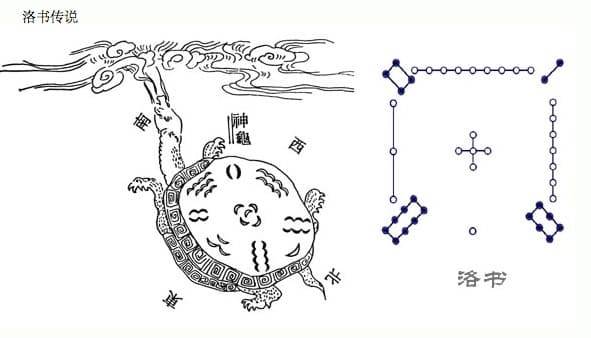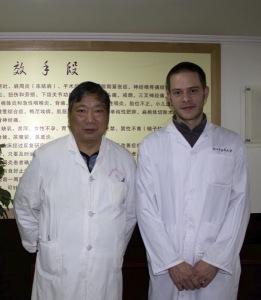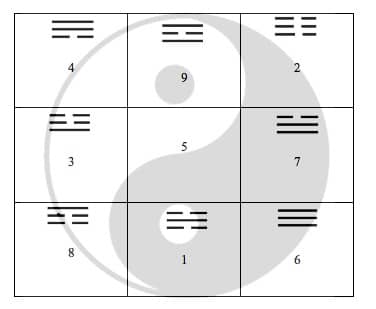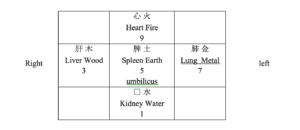Table of Contents
Abstract
This article introduces the Nine Palaces theory, which originates from the very ancient ‘He Tu’ and ‘Luo Shu’ maps. The theory is based on the Yi Jing and Ba Gua, and can be found in ‘Zhen Jiu Da Cheng’. The Nine Palaces theory has lot of guiding significance for Acupuncture. This theory is successfully used by doctor Feng Ninghan in his clinic. By using clinical case reports we aim to explain the application of the Nine Palaces Acupuncture in clinical practice and try to highlight the value of the Nine Palaces theory.
Keywords Nine palaces, Jiu Gong, Acupuncture, Yi Jing, I Ching, Luo Shu, Feng Ning Han
Introduction
The origin of the Nine Palaces (Jiu Gong)

Yu the Great, founder of the first empire, lived in the Xia dynasty around 2205 B.C. Yu was appointed to make the flooding from the Yellow river stop. “During his reign, King Yu controlled floods by regulating the Yangtze River and the Yellow River and by connecting all the watercourses. He dredged 300 large rivers, cleaned up 3,000 canals and channels and millions of smaller streams.”(1) “One day Yu stood on the banks of the Luo River, a tributary of the Huang He or Yellow River, a tortoise emerged from the water bearing on the under plate of its shell an array of symbols representing numbers.”(2) This diagram is known as the Luo Shu Tu, Luo Shu magic square, Nine Palaces diagram or Nine Halls diagram. “It is considered to be the graphic form of the ‘Great Plan’ described in the Classic of History which includes perhaps the earliest reference in Chinese literature to the Five Elements and their associated numbers. The tortoise…, whose back is round like Heaven and whose bottom is square and flat like Earth–it’s a representation of the microcosm.”(3)
The Luo Shu magic square
The magic square is a mathematical model of the universe. It can be used in astrology, feng shui and traditional Chinese medicine.
The diagram stands for the harmony between humanity and nature. The diagram expresses a number of systems of thoughts. It contains time, space, directions, the Five Elements, the Eight Triagrams, the Ying Qi cycle, Heaven-Human-Earth, San Jiao and the human body.
The square is composed of the numbers 1 to 9. The sum of each line, column and diagonal is 15. The odd numbers 1, 3,5,7,9 are defined as Yang numbers, while even numbers 2,4,6,8 are Yin numbers.
Nine palaces and their correspondences
In the Ling Shu chapter 78, Jiu Zhen Lun said:
Let me tell you how the body corresponds with the Nine Palaces.
The left foot corresponds with the beginning of spring. Its duty days are Wu Yin and Ji Chou.
The left hypochondrium corresponds with the Spring Equinox. Its duty day is Yi Mao.
The left hand corresponds with the beginning of summer. Its duty days are Wu Chen and Ji Si.
The throat and head correspond with the Summer Solstice. Its duty day is Bing Wu.
The right hand corresponds with the beginning of autumn. Its duty days are Wu Shen and Ji Wei.
The right hypochondrium corresponds with the Autumn Equinox. Its duty day is Xin Chou.
The right foot corresponds with the beginning of winter. Its duty days are Wu Xu and Ji Hai.
The loins, buttocks, external genitals and the anus correspond with the Winter Solstice. Its duty day is Ren Zi.
The six hollow organs, as well as the Liver, Spleen and Kidney are under the diaphragm in the Central Palace.
Number 1 / The Kidney belongs to Water, winter, the Kan Gua (Triagram) and lies in the North. Cold arises in the North. Cold easily attacks the Kidney. People with Kidney Yang Deficiency should face the South, when they are practicing Qi Gong, to absorb the Yang Qi of the Li Gua.
Number 9 / The Heart belongs to Fire, summer, Heat, the Li Gua and lies in the South. People with Yin Deficiency should face the North and avoid the South to gain the Water of Kan Gua.
Number 3 / The Liver belongs to Wood, spring, the Zhen Gua and lies in the East. People with Liver Yin Deficiency should face the North to let the Water of Kan Gua moisten the Liver.
Number 7 / The Lung belongs to Metal, autumn, the Dui Gua and lies in the West. People with Lung Dryness should face the North to absorb the Yin of the Metal and Water.”(4)
Number 5 / The Spleen belongs to Earth, harvest and lies in the Center. People with Middle Jiao problems should connect the Qi of Li and Kan Gua, Zhen and Dui Gua to tonify and regulate the middle.
Number 2 belongs to Earth, Kun Gua and the upper left limb and lies in the South West.
Number 4 belongs to Wood, Xun Gua and the upper right limb and lies in the South East.
Number 6 belongs to Metal, Qian Gua and the lower left limb and lies in the North West.
Number 8 belongs to Earth, Gen Gua and the lower right limb and lies in the North East.
The Nine Palaces Acupuncture and its clinical application
The Nine Palaces Acupuncture Method is mentioned in the ‘Zhen Jiu Da Cheng’ (The Great Compendium of Acupuncture and Moxibustion).
Principles:
Heaven – Human – Earth balance
To balance these three we treat three distinct parts of the body.
For Heaven we can use points on the upper Jiao, like Shen Ting (Du24), Yin Tang (Extra M-HN-3) or Tian Tu (Ren22).
For Human we use the Nine Palaces on the umbilicus.
For Earth we use the Eight Lines and Three Jiao (Burners) on the forearms and lower legs.
Nine palaces on umbilicus
We use the magic square on the umbilicus. Like put the square picture on the abdomen, then the No. 5 is corresponding to the umbilicus itself, No. 1 is inferior to the umbilicus, No. 3 is on the patient’s right side, No. 7 is on the patient’s left side and No. 9 is superior to the umbilicus.
Eight Lines and Three Jiaos on the limbs
On the limbs we have three burners. We divide the lower limbs and the forearms into three equal parts. The Upper Jiao is near the foot or hand while the Lower Jiao is near the knee or elbow. The Middle Jiao is between Lower and Upper Jiao.
The Eight Lines correspond to the Ba Gua. Line 1 is located on the posterior side of the lower leg and on the anterior side of the forearm. Line 3 is located on the lateral side of the lower leg and on the ulnar side of the forearm. Line 7 is located on the medial side of the lower leg and on the radial side of the forearm and Line 9 is located on the anterior side of the lower leg and on the posterior side of the forearm.
“Palpate the limbs along the lines and pay close attention to any variations in the tissue. If any areas feel particularly hot, swollen, strongly elastic, tender, or demonstrate subcutaneous sclerosis or hardening, this is an indication of Excess in the meridian. However, if they feel cool, depressed/indented, inelastic, or if pressing leads the patient to feel numbness but not pain, this is a Deficiency. If, when we touch, we can feel a callosity, tenderness, if we get a sensitive or even a pleasant sensation response at the point then this point is the disease point. If a point is very tender, this usually indicates an Excess Syndrome. If pressing results in a pleasant aching sensation, this usually indicates a Deficiency Syndrome. Disease points help us confirm our diagnosis, and often ‘thorn moxibustion’ can be used on these points to great effect. Also pay attention to color changes.”(5) White color usually indicates a Deficiency Syndrome while red color usually indicates an Excess Syndrome.
Needling technique
A special method of needling is the slow insertion technique. For the patient this is painless and has great effect. For the doctor it is a particularly difficult task. Without turning the needle, the needle is continuously held perpendicular to the skin without pressure. With prolonged retention Qi accumulates on the tip of the needle, until the needle penetrates the skin. The De-Qi can be so strong that no further needle stimulation is needed.
How to use in clinic
Case report:
Yu XX, Female, 43 years old, complaints: vague lower abdominal pain for 6 days after menstruation; these symptoms have appeared three times. Can’t fall asleep at night, feels depressed. Urination and defecation are normal.
Tongue color: red, the two sides have some red prickles.
Tongue coating: white.
Pulse: left side wiry. Right side weak in the guan position. On both sides the chi positions are deep and weak.
The umbilicus test: put middle finger on the umbilicus and index finger on the No.3 area, ring finger on the No.7 area according to the Nine Palaces and “heaven- human-earth” levels. Found the No.3 area is tighter than No.7 area, and in the No.1 area, the Earth level is empty. Also the local skin colour of the right lower abdomen is dim.
Treatment:
Heaven: Shen Ting (Du24)
Human: Needling the No.3 area on the abdomen with reducing method and tonifying the No.1 area.
Earth: Touching the surface of the limbs, and finding the eight lines on the leg, focus on the No.3 and No.7 lines on the left leg, and needling the middle Jiao (Zhong Jiao) area using reducing manipulation.
Analysis and Discussion:
This patient is a lady, suffering from pain after each menstrual cycle. Depression, insomnia and the pulse show she has Liver Qi stagnation, but she also has deficiency symptoms. We chose the No.3 line, and focused on the Middle Jiao (zhongjiao) area; this is to regulate the Liver Qi. Treating the No.7 is for balance, balancing the ‘Metal’ and ‘Wood’. We also found a color change in the No.7 Line, distal to the point San Yin Jiao (SP6): a white spot. We needled this point with a reinforcement manipulation. On the umbilicus we chose No.3 and No.1 for tonifying the Kidney Qi, to encourage the ‘Water’ to enhancing the ‘Wood’. These theories come from the Nine Palaces, which also emphasizes the concepts of correspondences and balance. After four treatments the pain lasted only one day after the menstruation. Her depression and insomnia also improved.
Dr. Feng Ning Han 冯宁汉 (馮寧漢)

Dr. Feng Ning Han, one of two sons of Dr. Feng Da Qi, was born in 1948 in Hangzhou. He started to learn traditional Chinese medicine from his father at the age of fourteen.
At the age of 19 he attended the Hangzhou University.
He headed the acupuncture department of the Railway hospital in Hangzhou for over 20 years until he retired in 2008.
He still works part-time in the Tong Jun Tang TCM clinic in Hangzhou. He also teaches his method to Chinese and foreign students in China and abroad.
Acknowledgment
It would not have been possible to write this paper without the help and support of the kind people around us, to only some of whom it is possible to give particular mention here.
We would like to express our deepest gratitude to our teacher, Dr. Feng Ning Han, for teaching us his acupuncture system and his excellent guidance, motivation, caring and patience.
We also would like to thank Anthony O`Connor for his input and his help with the translation.
References
- Qin Xuqing. Hunan Zhuang Zi – Library of Chinese Classics. People’s Publishing House 1999
- Swetz Frank J. Legacy of the Luoshu : the 4,000 year search for the meaning of the magic square of order three. 2nd ed. A K Peters, Ltd. 2008
- Eckman Peter. In the footsteps of the Yellow Emperor: tracing the history of traditional acupuncture. Long River Press. 2007
- Yang Li. Book of Changes and Traditional Chinese Medicine. 1.ed Beijing Science and Technology Press 1998
- Feng Ning Han. The Research of classical method of acupuncture [Lecture] Zhejiang Chinese Medical University. 2012

